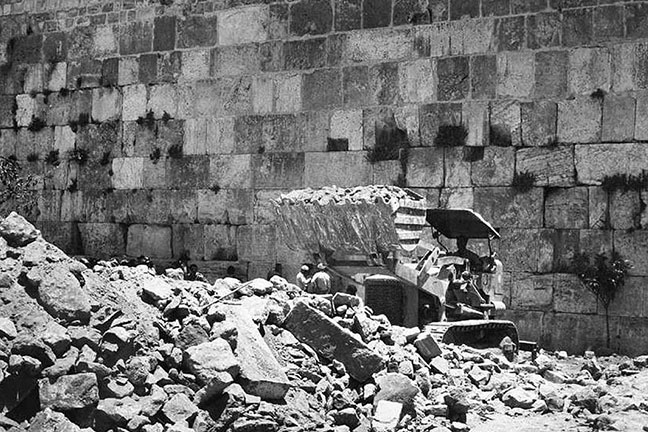It’s high time to quash the Palestinian lies about Jerusalem

The works at the Western Wall Plaza following its liberation in 1967. Photo by Kurt Meyerowitz/KKL-JNF Archive.
by Nadav Shragai
(Israel Hayom) — Last week’s Jerusalem Day marked the 57th anniversary of the city’s reunification. Now, the Palestinians’ unforgivable trivialization of the term “war crime” is claiming yet another victim: the Western Wall.
Palestinian media are recycling the false claim that the evacuation of the Old City’s Mughrabi Quarter during the 1967 Six-Day War, and the subsequent construction of the Western Wall Plaza on the site, constituted a severe breach of the laws of war.
The Palestinian Authority is also taking this story onto the international stage, and in the process is spreading more lies and disinformation regarding the Western Wall. For instance, that “the Jews have no ties with the Western Wall,” that “the fabricated link of the Jews to the Western Wall is a matter of no more than 400-500 years” and that “the Muslims own the exclusive religious, historical and legal rights to the Western Wall, which is part of Al-Aqsa.”
The P.A. took this one step further when it claimed that there is no documented record of the fact that the Jews designated the Western Wall as a site for ritual worship at any time, only doing so after the Balfour Declaration in 1917. On another occasion, it even vowed that the Mughrabi Quarter would be rebuilt on the site.
The Western Wall did indeed only become the Jews’ principal place of prayer in 1546, following the earthquake that rocked Jerusalem in that year. The earthquake caused the buildings adjacent to the Western Wall to collapse in the area we now know as the prayer plaza. It enabled the Turks to respond to the Jews’ requests and to allocate them an extremely narrow alleyway to be used for prayers.
But, in contrast to the derisory remarks of those who seek to deny the importance of the Western Wall to the Jews, this is no invention of only a few hundred years. Historical testimony shows that from the moment the Muslim conquest of the land allowed the Jews to return to Jerusalem, 1,000 years ago or even more (after the Christians had forced them out of the city), they prayed alongside the Western Wall, much of which was free of Muslim construction, unlike today.
The Cairo Geniza, which was discovered some 160 years ago in the attic of the Ben Ezra Synagogue in Cairo, also contained documentation of Jewish prayers at the Western Wall dating back to the ninth and 10th centuries.
In the short period during which Jordan ruled in Jerusalem’s Old City, 19 years (Israel has been the sovereign power there for 57 years now), it breached its written obligation to enable Jews to visit the Western Wall and pray there (Section 8 of the Armistice Agreement signed with Israel in 1949).
The evacuation of the Mughrabi Quarter and its demolition in the Six-Day War was an act of pure historical justice concerning the residents of that quarter, settling the centuries-old score with them. Thus, it was also possible to remove the latrines and sewage pipes they had built there and placed right next to the stones of the Western Wall, desecrating the holy site.
This also paved the way for hundreds of thousands of Jewish worshippers to gather together for prayers at the Western Wall (the old, narrow Western Wall passageway accommodated no more than a few hundred people crammed into an extremely crowded space).
The Arab families who were evacuated from the Mughrabi Quarter—living in dilapidated houses and squalor, which according to the documents of the Jordanian municipality, were due to be demolished in any case—were awarded financial compensation and alternative accommodation. They even wrote a letter of thanks to the then-mayor of Jerusalem, Teddy Kollek.
Smuggled out of Al-Azhar
There is a long list of Muslim sources and clerics who for some 1,350 years have identified the Temple Mount as the site of the Jewish Temple.
The first one to do so was the Persian historian Abū Jaʿfar Muḥammad ibn Jarīr ibn Yazīd al-Ṭabarī (838-923), who was one of the first, most prominent and renowned commentators on the Quran and the Muslim tradition. One of his ancient manuscripts, which bears the seal of Cairo’s Al-Azhar University—the most important study institute in the Sunni Muslim world—was photographed and smuggled years ago by Noha Hassid (originally an Egyptian Muslim named Noha Hashad).

Jews at the Western Wall, 1870s. Photo by Félix Bonfils/Getty Villa via Wikimedia Commons.
The text, which was also previously known, once again began to fan the flames. Al-Ṭabarī writes there, among others: “Bayt al-Maqdis [the Temple Mount] was built by Solomon, the son of David.”
This documentation, from a pillar of Islam such as al-Ṭabarī, clearly contradicts the efforts of many Muslims to rehash the history of the Temple Mount in recent years. Just like al-Ṭabarī, there are dozens more Muslim clerics from earlier periods in history.
Three years ago, an “End of Days Conference” was held in Gaza under the auspices of Hamas leader Yahya Sinwar. Here they did not only deal with Al-Aqsa but also the issue of the “right of return.” The conference and its content were exposed by the Middle East Media Research Institute (MEMRI), and then by Israel Hayom, but the Israeli media did not attribute much significance to it. During the conference, Sinwar spoke of “the full liberation of Palestine, from the river to the sea, and the return of the Palestinian refugees to their homes.”
The conference chairman, Kna’an Obeid, explained that the organization has “… lists of the numbers of the apartments and the Israeli institutions, educational institutions, schools and power plants, and there is no choice but to prepare to run them. … We believe that the liberation will be completed within a few years. If Israel ignores this warning, this will be an unprecedented historical event both on a regional and a global scale, and it will indeed have global implications.”
The conference’s closing announcement included descriptions of the various dimensions of the “liberation” and the “return” to the “1948 lands,” and it also mentioned the practical assistance that would be provided to those returning refugees as well as the plans for the absorption of the Palestinians back in their cities of origin.
One of those cities of origin is of course Jerusalem. It was the P.A. and not Hamas, with help from the Turks, that documented 7,000 buildings (in western Jerusalem) in which Arabs had resided before the War of Independence, including photos, addresses and their land registration extracts. Apart from winning the war over hearts and minds for the Temple Mount and Al-Aqsa, Hamas and the P.A. also seek to implement the plan for the return of the Palestinian refugees, and first and foremost, this means Jerusalem.
Think big: Expand the city
Demographic math has accompanied us here in Jerusalem since the city was reunified, almost for 60 years now, various ministerial committees for Jerusalem have defined a positive Jewish demographic balance as a goal.
In 1967, we began with 74% Jews and 26% Arabs. Today, the ratio in terms of percentage is 60:40 in favor of the Jews. In 1967, there were 69,000 Arabs in Jerusalem. Today, there are some 400,000 Arab residents. The Arab population has grown sixfold. In 1967, only 200,000 Jews were living in Jerusalem, and today there are some 600,000. The Jewish population has tripled.
Despite the reversal in the fertility rate—in the Jewish sector of the population this stands at 4.3 children per woman, while among the Arabs this amounts to 3 children per woman—the Arab majority has been growing mainly due to the negative Jewish migration from Jerusalem. Approximately 18,000 Jews leave the capital each year. Many fewer Jews come to live there annually. This is referred to as a “negative migration balance.” Over the last 45 years, hundreds of thousands of Jewish residents have left the city.
There is a relatively simple method that should make it possible to contend with the Jewish demographic plight in Jerusalem, but that requires political courage and vision. The Arab neighborhoods located beyond the security fence, a veritable “Wild West” rife with crime, drugs, illegal building and terrorism, complete with a huge Israeli governmental vacuum, are inhabited by about one-third of the population of eastern Jerusalem; some 140,000 people.
It is possible to remove these neighborhoods from the municipal boundaries of Jerusalem without removing them from the territory of the State of Israel and then to establish for them separate local Israeli councils. The resident permits of the inhabitants of these areas, from across Kafr ‘Aqab and the Shuafat refugee camp, will remain in their possession, and because they live within the bounds of the State of Israel, they will continue to enjoy their resident status along with the economic benefits that are part of this.
At the same time, we should begin to establish an official municipal link between Jerusalem and the Jewish communities in the “Greater Jerusalem” area, a term coined by the late prime minister, Yitzhak Rabin.
In 1998, the first government of current Prime Minister Benjamin Netanyahu decided to establish an umbrella municipality for Jerusalem and its Jewish satellite towns, such as Ma’ale Adumim, Gush Etzion and Givat Ze’ev, but this decision was never implemented. The Americans saw to that, even though it merely involved municipal annexation rather than the application of Israeli law.
Now, when the deck of cards has been reshuffled, it might be a good time to revisit that idea. If the northern Arab neighborhoods are removed from Jerusalem and the Jewish neighborhoods in the surrounding communities are municipally annexed to the capital, the demographic situation in Jerusalem will dramatically improve in favor of the Jews.
Then, Jerusalem, in terms of hearts and minds too, will cease to remain merely a city. It will also become a metropolis. This will also facilitate an end to the insufferable crowding of Jerusalem within its current municipal boundaries, which harms both the beauty of the city and the quality of life of its inhabitants, as well as enabling much more expansive construction of housing units for the Jewish population in “Greater Jerusalem.” Now is the time to step up to the plate.
Originally published by Israel Hayom.



